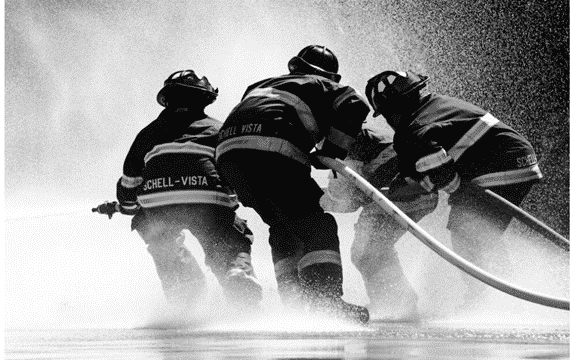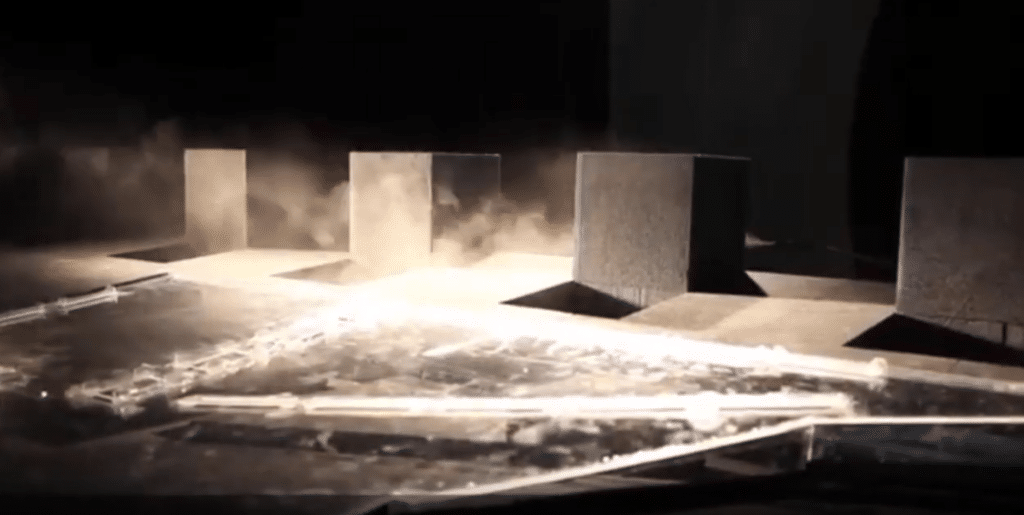Smoke extraction in underground parking lots
Accueil » Smoke control » Smoke extraction in underground parking lots
Smoke extraction in underground parking lots
Ventilation and smoke extraction systems are crucial to safety in underground parking lots. Due to the concentration of exhaust gases and the risk of fire, it is essential to install air treatment systems to prevent the risk of intoxication and to enable evacuation in the event of an emergency.
French regulations impose specific standards for smoke extraction in parking lots, particularly with regard to system dimensions and location.
Our smoke ventilation projects :
The importance of ventilation and smoke extraction systems in underground parking lots.
Smoke hazard:
In underground parking lots, , it is essential to install toxic gas evacuation systems to ensure the safety of occupants.
Due to the intensive use of motor vehicles inside these enclosed spaces, the concentration of exhaust gases can reach levels that are hazardous to health.
To prevent any risk of poisoning, it is compulsory to install suitable air treatment systems such as mechanical ventilation.

Simulation of a car fire in a parking lot
These systems renew the air, reducing concentrations of harmful pollutants.
They must be sized to effectively counteract even local stagnation of noxious or flammable gases.
In addition, fire safety is of paramount importance in underground parking lots. It is very difficult to maintain a smoke-free height of over 2 meters in the event of a fire.
Ceiling heights are often low, and vehicle fires release large quantities of heat and smoke.
The approach must therefore be different from other premises, where the primary concern is to maintain passable escape routes for occupants, while preserving smoke stratification as far as possible.
In this context, the main role of the smoke extraction system is to enable the emergency services to locate the source of the fire and access it in the best possible conditions to engage fire-fighting resources.
In addition, smoke propagation beyond the affected level and compartment must be limited.
Access to the compartment must also be smoke-free throughout its entire height.
The installation of these toxic gas evacuation and smoke extraction systems meets a fundamental need to protect occupants against the risks of intoxication and asphyxiation in the event of fire.
These safety measures guarantee clean air and the safety of underground parking lot users.
Modeling a parking lot fire - Visibility through smoke and temperature
French regulations on smoke extraction in parking lots:
Smoke extraction in underground parking lots in compliance with the decree of June 25, 1980
The main regulatory text governing smoke extraction in covered parking lots is the modified Order of June 25, 1980, approving the general provisions of the safety regulations against the risks of fire and panic in establishments open to the public: it classifies establishments open to the public into types, according to the nature of their operation.
They are then classified into two groups:
- 1st, 2nd, 3rd and 4th category establishments
- 5th category establishments.
This classification is linked to the establishment’s capacity. Fifth-category establishments are those receiving the public in which the number of people admitted is less than the numbers set for each type of operation.
Underground parking lots are PS-type facilities.
French regulations differentiate between two types of underground parking lots: residential parking lots and parking lots linked to public buildings (ERP) and high-rise buildings (IGH).
Both types of parking lot must comply with specific smoke extraction regulations. Residential parking lots and parking lots linked to buildings governed by the Labour Code are not affected by these rules.
The regulations apply to covered parking lots with a capacity of more than 10 vehicles and not exceeding 3.5 tons.
In addition, there is the “Guide de préconisations relatif aux dispositions prévues pour la sécurité incendie dans les parcs de stationnement couverts ouverts au public” (Guide to fire safety provisions in covered car parks open to the public ) drawn up by the Direction Générale de le Sécurité Civile et de la Gestion des Crises, which groups together all the rules applicable to this type of establishment.
General rules for smoke extraction :
As explained above, in underground parking lots it is very difficult to maintain a smoke-free height of more than 2 metres due to the low ceiling height and high fire power.
This is why smoke extraction systems in parking lots are based on the sweeping principle.
The aim is to keep smoke within a restricted area of the parking lot.
To achieve this, the air movement in the parking lot must be correctly directed, from the air inlets to the outlets, and have a velocity of between 0.5 and 1.5 m/s. The sweep must also be directed in such a way as to limit smoke rising up the access ramps.
This is why smoke extraction systems for underground parking lots can be either natural or mechanical.
Natural smoke extraction is generally preferred for small-scale residential parking lots, while mechanical smoke extraction is often used in parking lots used by public and private buildings.
Certain rules apply regardless of the type of smoke extraction system chosen.
For example, air inlets must be located in the lower part of parking lots, to maintain smoke stratification.
Air extractions, on the other hand, should be located in the upper part of the parking lots, to allow direct extraction into the smoke layers.
Air fines and extractions must never be blocked by a vehicle, for example.
It may be necessary to create a no-vehicle zone around the vents.
The same applies to the proximity of access ramps, to limit the flow exchanged between levels.
In addition, underground parking lots are divided into compartments, which must not exceed a surface area of 3000m².
However, if the parking lot is equipped with a sprinkler system, this limit can be raised to 6000m².
This division into compartments limits the spread of flames and smoke in the event of a fire, making it easier to evacuate users and preventing the fire from spreading to the whole parking lot.
It’s also important to note that underground parking lots must be equipped with emergency lighting to guide people to emergency exits in the event of a power failure.
These emergency lights must be powered by an autonomous energy source, such as a back-up battery, to guarantee their operation in all circumstances.
Natural smoke ventilation :
Natural smoke ventilation is authorized for single-level underground parking lots located at reference level.
For this type of smoke extraction to comply with safety standards, fresh air supply and smoke extraction openings must have a minimum free surface area of 12 square decimeters per vehicle impacted.
These openings can take various forms, such as ventilation grilles, windows, hatches or specific openings designed to allow air circulation and smoke evacuation in the event of a fire.
This requirement is designed to ensure a sufficient supply of fresh air into the parking lot to limit the spread of toxic fumes and facilitate the evacuation of users in the event of a fire.
It’s important to stress that this minimum surface area of 12 square decimeters per vehicle must be respected for both fresh air supply and smoke extraction openings.
This is not a cumulative sum for these two functions, but an individual requirement for each of them.
Modeling a parking lot fire - Visibility through smoke and temperature
Mechanical smoke extraction :
The rules for mechanical smoke extraction in underground parking lots are applied on a compartment-by-compartment basis, with the aim of limiting smoke propagation in the event of fire.
The air extraction rate is calculated according to the number of spaces available in the parking lot.
The air extraction rate is set at 900 m³ per hour, per vehicle and per compartment.
However, if the parking lot is equipped with a sprinkler system, the air extraction rate can be reduced to 600 m³ per hour, per vehicle and per compartment.
Sprinklers are fire extinguishing devices that release water when heat is detected, helping to bring the fire under control and reduce smoke production.
The presence of a sprinkler system therefore reduces the extraction flow required for smoke extraction in the parking lot.
To guarantee effective smoke extraction, extraction systems must have a fire resistance of 200°C for 1 hour.
For mechanical air supply systems, the supply flow rate must be 0.75 times the extraction flow rate.
The purpose of this is to create a negative pressure in the affected volume, thereby limiting the spread of smoke to other levels. However, to maintain smoke stratification, supply air velocities must not exceed 5m/s.
Jet fan systems play an important role in smoke extraction engineering for underground parking lots.
Their ability to generate a directional flow of air creates an efficient sweep of smoke and maintains a breathable atmosphere for users in the event of fire.
Jet Fans: an essential preliminary study for optimum installation
Jet Fans are designed specifically for use in underground parking lots and tunnels.
They are strategically installed on the walls or ceiling of the parking lot to promote good air circulation.
Thanks to their power, they help push fumes towards exhaust openings, helping to keep spaces free of toxic fumes.
Another advantage of Jet Fans is their ability to reduce dead zones, i.e. areas where air flows less efficiently.
By creating a continuous flow of air, Jet Fans help minimize these zones, improving overall smoke extraction efficiency.
Theinstallation of Jet Fans in underground parking lots requires a thorough preliminary study, taking into account the specific characteristics of the parking lot, such as size, ceiling height and required air flow.

Air movement created by jet fans
Smoke extraction engineering as a sizing tool
Scenario modeling :
The aim of smoke extraction engineering is to design and install effective systems to evacuate smoke from buildings in the event of fire. Smoke extraction is an essential part of fire safety, as it reduces the risk of asphyxiation, improves visibility and facilitates rescue operations. It is based on a rigorous technical and regulatory approach.
It requires a precise analysis of the building’s characteristics, such as surface area, height, number of storeys and type of occupancy.
These factors determine smoke ventilation requirements, particularly in terms of air flow rates and the number of smoke vents.
Underground parking lots are particularly complex and highly regulated enclosed spaces to smoke out.
Because of this complexity, smoke extraction engineering is particularly well suited to this type of establishment.
Itoptimizes the placement of extractions and supplies to ensure correct sweeping throughout the compartment, and minimizes dead zones that are not conducive to smoke evacuation.
The installation of additional systems such as Jet Fans may be necessary to improve smoke control.
Preliminary smoke control studies enable this type of system to be optimally positioned to maximize their effectiveness.

Coefficient of extinction in an underground parking lot access ramp
During a fire risk assessment, several scenarios are identified as being the most likely in underground parking lots.
One of these scenarios is a car fire in the lower levels of the parking lot.
Vehicle fires can generate large quantities of heat and smoke, requiring rapid and efficient smoke evacuation to ensure the safety of occupants.
Another possible scenario is a fire at an electric charging station.
With the growing popularity of electric vehicles, charging stations are increasingly present in underground parking lots.
In the event of a fire due to a charging station malfunction, it is essential to assess the impact on fire safety and model smoke dispersion to take appropriate action.
By modeling these scenarios using simulation tools, we can analyze smoke behavior, determine the most appropriate evacuation routes andoptimize the design of smoke extraction systems.
This ensures that the specific risks associated with these scenarios are taken into account, and that firefighters can respond effectively in the event of a fire.
By incorporating these scenarios into smoke extraction studies, we can ensure that ventilation and smoke extraction systems are adapted to the actual conditions that may arise in underground parking lots.
This contributes to enhancing occupant safety, minimizing potential fire-related risks and enabling emergency services to intervene in the best possible conditions.
EOLIOS: Cutting-edge CFD and smoke extraction studies for fire safety
EOLIOS Ingénierie’s expertise in aeraulic and thermal modeling and CFD studies, as well as its competence in fire safety engineering, make it a privileged partner for smoke ventilation studies.
Thanks to its experience and in-depth knowledge of current technologies and standards, EOLIOS is able to meet the specific challenges of smoke ventilation in underground parking lots and other public buildings.
The experience gained from previous CFD and smoke extraction studies gives EOLIOS an in-depth understanding of the specific challenges of underground parking lots, such as low ceiling heights, the presence of large numbers of vehicles and strict regulatory constraints.
This expertise enables EOLIOS to offer tailor-made solutions, guaranteeing compliance with safety standards and ensuring the safety of occupants in the event of an incident.
> Read more :
Smoke control : on the same subject

Sprinkler: how does a sprinkler system work?

Fire safety engineering

Data center fire safety: Automatic Gas Extinguishing Systems (IEAG)

File: applying IT263 – smoke extraction from atriums

File: applying IT246

The ESSOC law for fire safety

The objectives of smoke control

Dynamic modeling of the evacuation of people

CFD simulation: An alternative to wind tunnel testing











